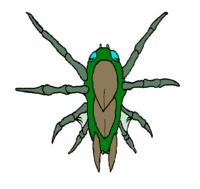Parting of the Ways (Fortune: Evolution Game): Difference between revisions
1d4chan>Stooge No edit summary |
1d4chan>Stooge No edit summary |
||
| Line 54: | Line 54: | ||
Silverwyrm (Arctic Serpent) | Silverwyrm (Arctic Serpent) | ||
Barkworm | ===Barkworm=== | ||
[[File:Barkworm_00.png|200px|thumb|Barkworm]] | |||
'''Barkworms''' are omnivorous insectoids that make their homes inside burrows carved out of tree-trunks. They are found wherever there are trees, and so are most common in the regions of the Northern Wildwood and the Equatorial Jungles. | |||
Barkworms are a creatures that has changed very little in millions of years. They inhabit the inside of trees, helping to clean out dead bark and rotten roots, the way cleaner fish pick dead skin off larger fish on Earth. The Barkworms will also not hesitate to eat deceased animals either, provided they are not far from the creature's burrows (such burrows are either bored into the tree itself or are in the dirt beneath its roots). | |||
Barkworms are about the size of a human hand. | |||
Tunnelsinger (Howling Snake) | Tunnelsinger (Howling Snake) | ||
Revision as of 20:21, 12 June 2012
"Parting of the Ways" is the sixth chapter in the evolution game run by FortuneHost. The name is a reference to the lyrics of an Irish protest song, but also refers to the splitting of the continents that has occurred. For now, these are tentatively named Alpha, Beta, and Delta continents. Unlike other games, Part 6 is split into regions, with a thread dedicated to each area rather than the world as a whole, as now creatures are separated and should evolve differently in their varied environments.
ARCTIC
Demolisher
Imperial Wolf
Snow Crabs
Snow Tick
White Wretch (Grey Wretch)
-
DESERT
Sailbacks (Sailed Wretch)
Longnecks
Sand Crusher
Blood Ants (Sand Tick)
Gel-Moles
Skunk Bison (Binger)
Sultan Roo
Sandhopper
Screamer
Spearcow
Piranha Moth
-
Forests
Webspinner

Webspinners are terrestrial insectoids that prefer cool, damp spaces and are commonly found in the shade of the trees of the Jungle Region with a separate population in the Forest Region. Over time these may develop into two different species, but for now, they are physiologically identical.

Webspinners are predatory creatures about 3 inches long and make their homes in the boughs and shade of trees. It is here that they build their nests, spinning them into tightly woven funnels, held between two small branches like a sideways hammock. While Webspinners do not build web traps like many Earth spiders, the Webspinner can, however, fire a sticky mass out of their abdomen (the same area from where their web comes from, incidentally. Usually this is used to bind the webbing of their homes to the bark of a tree, but it is also how the creature catches prey. The aim has to be precise, but once a smaller creature gets stuck within, there is little escape. The prey is either glued to the tree branch or, if flying, falls to the ground.
Should the fall not kill the flyer, the Webspinner will soon put it out of its misery. Shooting a creature out of the sky is far more difficult than firing at a target situated on the branch, so the Webspinner usually prefers to hunt more land-bound food as an ambush predator, sneaking up and pouncing on the prey (or immobilizing it with sticky goo) before it has time to escape or react at all.
Silverwyrm (Arctic Serpent)
Barkworm

Barkworms are omnivorous insectoids that make their homes inside burrows carved out of tree-trunks. They are found wherever there are trees, and so are most common in the regions of the Northern Wildwood and the Equatorial Jungles.
Barkworms are a creatures that has changed very little in millions of years. They inhabit the inside of trees, helping to clean out dead bark and rotten roots, the way cleaner fish pick dead skin off larger fish on Earth. The Barkworms will also not hesitate to eat deceased animals either, provided they are not far from the creature's burrows (such burrows are either bored into the tree itself or are in the dirt beneath its roots).
Barkworms are about the size of a human hand.
Tunnelsinger (Howling Snake)
Gardenback
Ice Beetles
Forest Tick
Cleaner Tick
Grey Wretch
-
HIGHLANDS
Garden Crab
Tunelsinger (Howling Snake)
Mountain Troll (bull Chomper)
Smiler
Dwarf Chomper
Czar Boar (Jelly Boar/Metalhead)
Highlands Tick
Spitter Crab
Brown Wretch - JUNGLES
Webspinner
Barkworm
Garden Crab
Howling Snakes
Rainbow Blimpie
Smiler
Skullroot
Saltspike Frog
Jungle Tick
-
PRAIRIE
Camelback
Demolisher
Imperial Wolf (Gel Wolf)
Czar Boar (Jelly Boar/Metalhead)
Prairie Tick
Spitter Crab
-
SWAMPS
Spearfish
Saltspike Frog
Swamp Tick
Strider Crab
Smiler
-
VALLEY OF THE GIANTS
Demolisher
Behemoth
Marauder
ABYSS
Tentacle Leech
Shadow Raveshark
Abyssal Ravedragon
Aquabeast
Rock Slug
Stingers
-
OPEN OCEAN
Spearfish
Openwater Ravedragon
Aquabeast
Bloat Whale
Common Searay (Northern Ice Ray)
Tentacle Leech
Windsail Dolphin
Common Raveshark
Shadow Raveshark
Stingers
-
TROPICAL GULF
Tropical Searay (Southern Ice Ray)
Tentacle Leech
Shadow Raveshark
Common Raveshark
Rock Slug
Fire Guppy
Treasure Fish
Stingers
PICKLE ISLAND
VOLCANO ISLAND